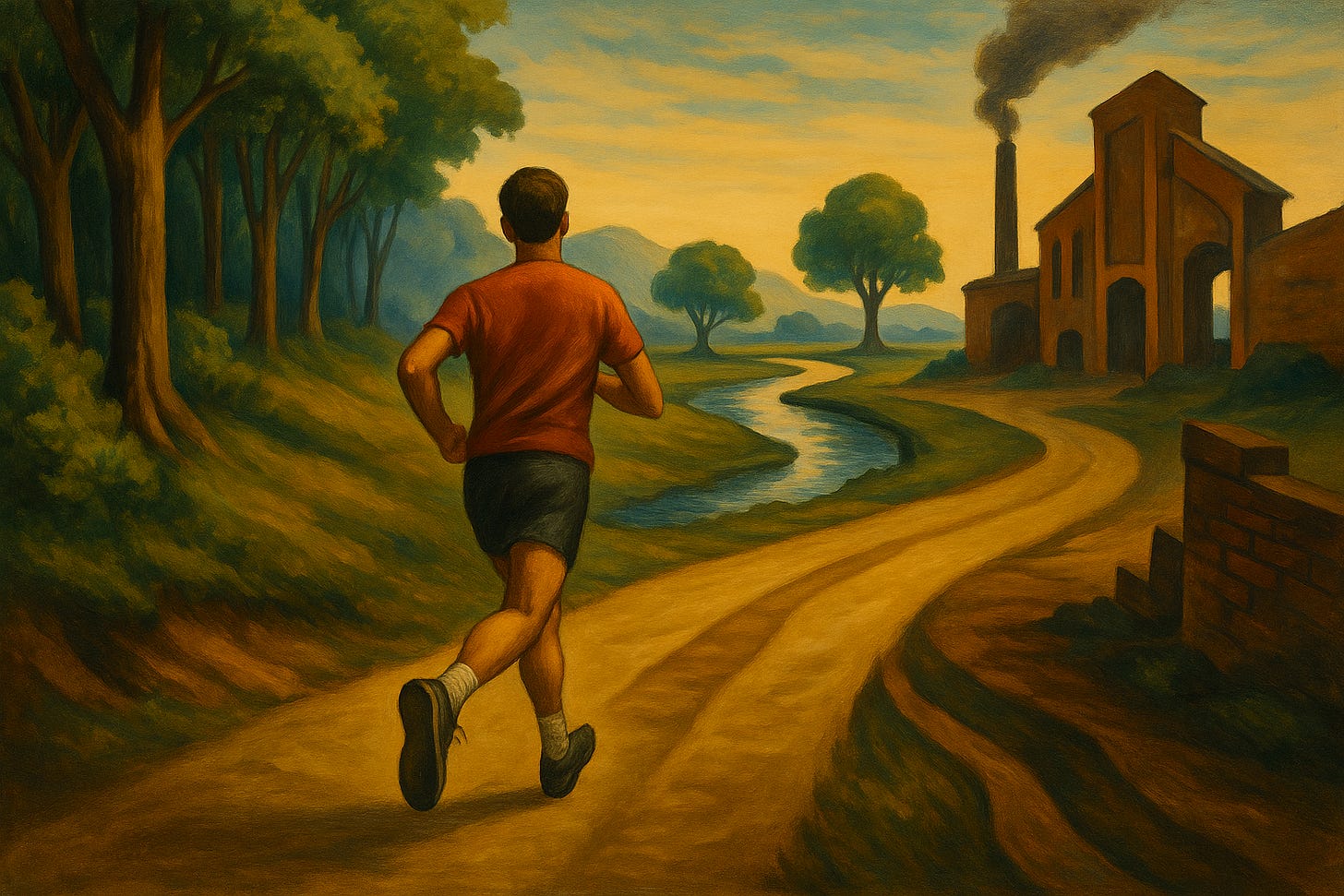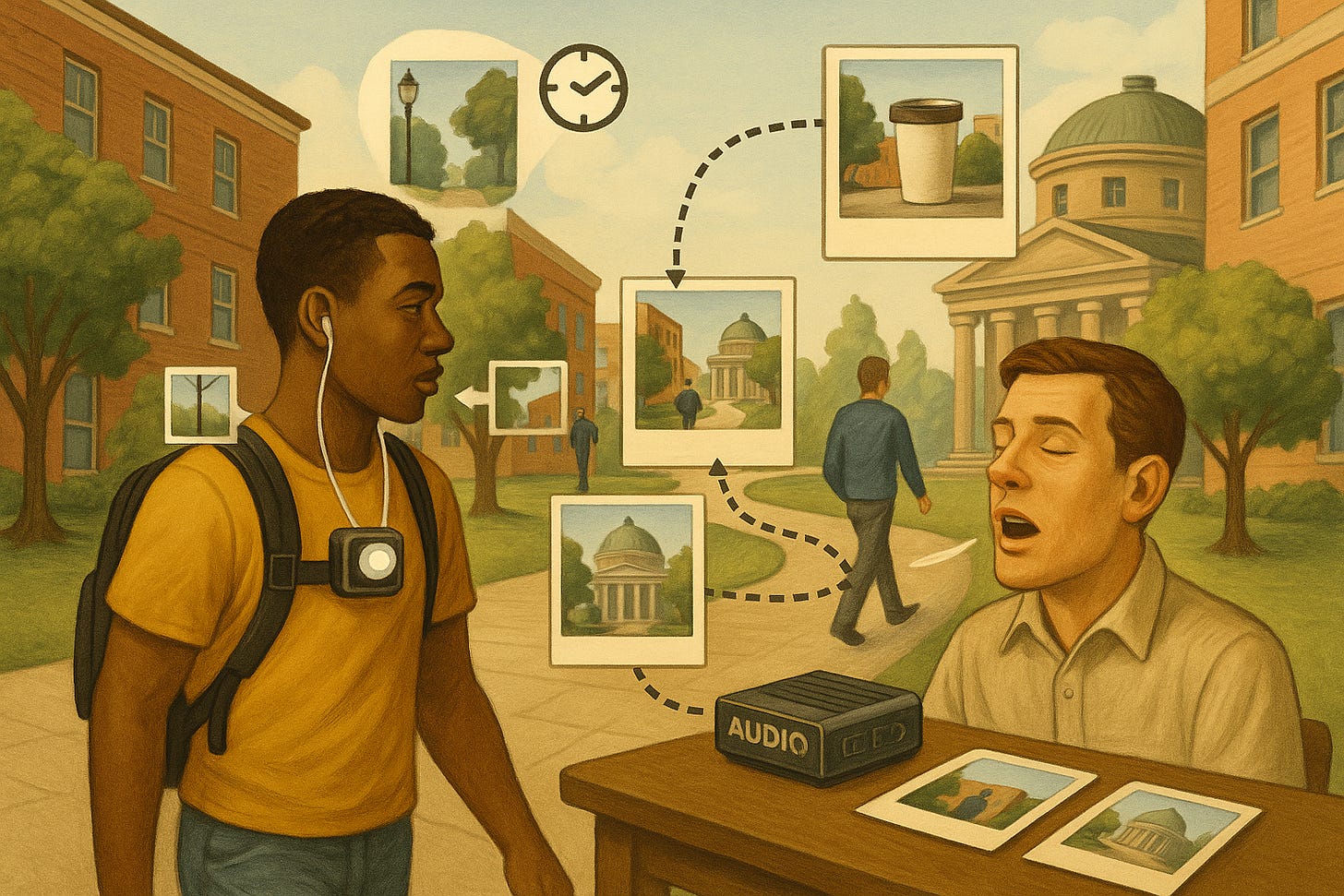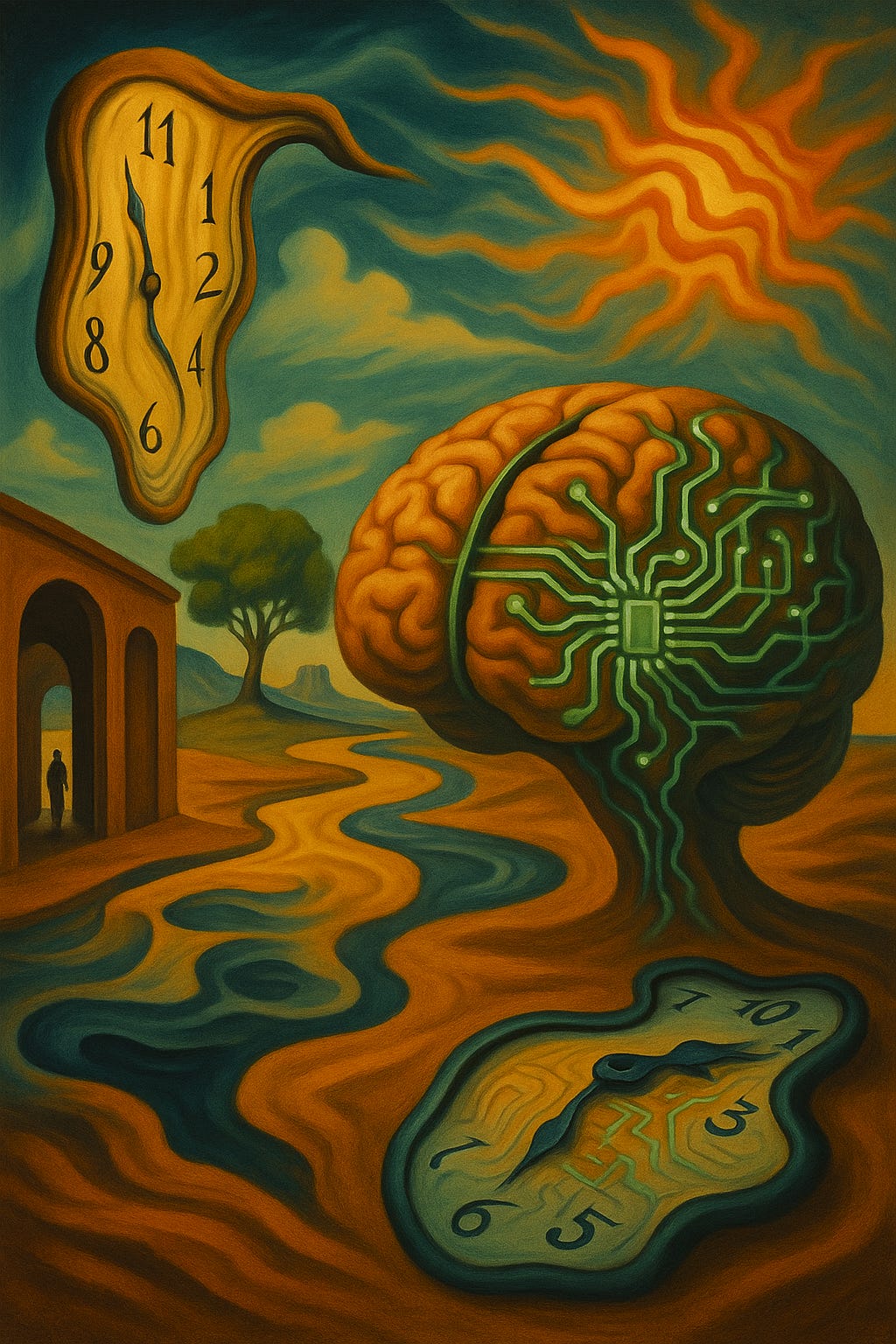Over the past year, I’ve found a new favorite running trail. It winds through woods, follows riverbanks, and slips through an old industrial complex. The scenery shifts constantly, broken into short, distinct segments.
I was surprised to discover that the run takes about an hour, almost exactly the same as my old trail from the year before. The distances are nearly identical too, which makes sense given that my pace hasn’t changed. And yet, the new trail feels much longer. How come?
The old route was simpler. It had three long, straight stretches where I could see the end from the beginning. Easy to remember, easy to chunk. The new one is nothing like that: shorter segments, sharper turns, and ever-changing backdrops. Every few minutes you’re in a completely new setting, never quite sure what’s around the bend.
That difference got me thinking about how we perceive time. We’ve all had those strange distortions: a memory from years ago that feels recent, or something from last week that feels impossibly distant. Time in the brain is slippery.
So how do we actually track it? Is there an internal clock ticking away? Probably not: decades of searching haven’t turned one up. A more likely explanation is that time is tied to how memories are organized and indexed. Let’s dig into what we actually know.

How Memory Creates Time
The first clue comes from studying what happens when we remember. In a clever set of experiments, Olivier Jeunehomme and Arnaud D’Argembeau asked people to wear small automatic cameras while walking around a university campus. The cameras snapped photos every few seconds, creating an objective record of the experience. Later, participants were asked to verbally recall their walks while being audio-recorded.
The campus walks lasted around 40 minutes, but when participants replayed them aloud in memory, the descriptions only took about 5 minutes on average. That is roughly an eightfold compression of time.
The compression, however, was uneven. The researchers compared the recall transcripts to the time-stamped camera sequences and divided the narratives into what they called “experience units.” These were discrete remembered moments, such as buying a coffee, turning into a courtyard, or chatting with a classmate. Each unit was mapped back to the original footage so they could calculate how much real-world time it spanned.
The pattern was striking. Short, bounded activities with a clear goal, like making a purchase or opening a door, tended to be preserved in relatively high detail, replayed at about four to five times compression. In contrast, transitional stretches of locomotion, like walking from one building to the next, were compressed far more, sometimes by a factor of twenty or more. Long, uneventful stretches collapsed into a single unit, while activity-rich episodes retained much finer granularity.
These experience units appear to be the basic building blocks of episodic memory. The density of such units determines how long an episode feels in retrospect. More units per minute of clock time make for a richer memory trace and an expanded sense of duration. Fewer units create a thinner trace and a contracted sense of time.
Follow-up studies have highlighted the special role of event boundaries. Jeunehomme and D’Argembeau found that moments marking a change in context, such as entering a building, turning a corner, or meeting a person, were about five times more likely to be recalled than stretches in between. Boundaries act like bookmarks, segmenting the stream of experience and anchoring the flow of time in memory. These anchors not only determine what is remembered, but also shape how long the remembered experience feels.

The Paradox of Event Boundaries
Experience units and event boundaries create a fundamental paradox in how we perceive time. Bangert and colleagues (2019, 2020) ran a series of experiments in which participants watched short films of everyday activities while making timing judgments. The films were paused at different points, and participants were asked to estimate whether a brief interval, usually around five seconds, had just passed. The twist was that sometimes the interval contained an event boundary, such as finishing washing dishes and beginning to dry them, and sometimes it did not. Intervals that contained a boundary were consistently judged as shorter than otherwise identical spans without one.
The mechanism behind this compression may become clearer when considering what’s happening in working memory. Swallow and colleagues (2009) tracked this directly by having participants watch movie clips while objects appeared on screen, a knife during sandwich-making, a towel during dishwashing. Five seconds later, the movie would pause for a recognition test. Objects present at event boundaries were recognized significantly better than those at non-boundaries. But this enhancement came with a cost: memory for objects from just before a boundary dropped dramatically. The boundary created a barrier, making it harder to retrieve information from the previous event even though it had occurred mere seconds earlier.
Event Segmentation Theory, developed by Jeffrey Zacks and colleagues in 2007, provides the framework. According to their theory, event boundaries are when the brain discards its current “event model” from working memory and uploads a new one. This updating process requires attention, which leaves fewer resources available for keeping track of time. As Bangert and colleagues (2020) demonstrated using dual-task paradigms, devoting attention to updating perceptual and conceptual features of the activity left fewer attentional resources for accumulating temporal information. It’s like trying to count seconds while also solving a puzzle – each boundary forces you to solve a new puzzle, and your counting falters.
The paradox is that the very same boundaries that compress time during experience expand it in memory. They serve as landmarks that structure recall, making events feel more spacious in retrospect. This dual effect helps explain a familiar puzzle: why the drive home from a new place usually feels longer than the drive there. On the outbound trip, the brain is constantly updating its models: pass the gas station (boundary), turn at the intersection (boundary), merge onto the highway (boundary). Each update reduces attention for tracking duration, so the drive feels shorter while you are in it. Yet those boundaries also create anchors that expand the memory of the trip. On the return drive the route is familiar, there are fewer surprises, and the brain needs fewer updates. With less attention diverted, duration is tracked more faithfully, so the drive feels longer in the moment but compresses more in memory.
Bangert and colleagues (2019) also tested temporal proximity, asking participants to judge how far apart two moments in the film felt. Boundaries made items seem further apart in time, even when the objective duration was identical. In this sense, boundaries insert psychological distance between moments. They stretch the remembered timeline even while compressing the lived experience of duration.

The Implications
This framework explains a wide range of everyday paradoxes. Vacations, filled with novelty, fly by while they happen but expand richly in memory. Daily routines, stripped of boundaries, drag while we live them but collapse into nothing when recalled. Clewett and Davachi (2017) argued that the ebb and flow of experience itself determines the temporal structure of memory. Lositsky and colleagues (2016) showed that the greater the number and diversity of boundaries, the more time expands in recall.
It explains my running puzzle. My old trail was made up of long, predictable stretches, so it generated relatively few event boundaries. My new trail, by contrast, forced segmentation at every turn: woods to riverbank, riverbank to industrial ruins, sharp corner, sudden hill, unexpected vista. Each transition became a boundary, a new chunk in memory. The clock says both trails take about an hour, but memory disagrees. The old one collapses into a few coarse segments, while the new one expands into a much longer-feeling journey.
The principle is simple: if you want something to feel substantial in memory, add boundaries. Change contexts, vary activities, create moments that require updates. If you want time to flow by quickly, keep it continuous and predictable.
But the implications go deeper than personal experience design. This mechanism may explain why time seems to accelerate as we age. Childhood is packed with firsts, each creating boundaries: first day of school, first sleepover, first kiss. Adult life, especially in stable careers and relationships, can become a series of similar days bleeding into each other. The years feel shorter not because our metabolism changes or because of some cosmic injustice, but because we’re creating fewer distinct memory segments.
The brain doesn’t keep time like a clock. It builds time from its internal dynamics. The elasticity of time isn’t an illusion; it’s how the mind constructs a temporal dimension from the boundaries of experience.

If you enjoyed this piece, let me know. I’d love to hear how you’ve experienced time stretching or compressing in your own life. I’ll also be following up with another post that digs into the neural substrates of time perception, exploring how brain circuits generate these distortions.
If you’d like to read that when it comes out, consider subscribing or sharing this piece with someone who might find it interesting.
Bibliography
Bangert, A. S., Kurby, C. A., Hughes, A. S., & Carrasco, O. (2019). Crossing event boundaries changes prospective perceptions of temporal length and proximity. Attention, Perception, & Psychophysics, 81(8), 2459-2472.
Block, R. A., & Zakay, D. (1997). Prospective and retrospective duration judgments: A meta-analytic review. Psychonomic Bulletin & Review, 4(2), 184-197.
Clewett, D., & Davachi, L. (2017). The ebb and flow of experience determines the temporal structure of memory. Current Opinion in Behavioral Sciences, 17, 186-193.
Jeunehomme, O., & D’Argembeau, A. (2020). Event segmentation and the temporal compression of experience in episodic memory. Psychological Research, 84(2), 481-490.
Lositsky, O., Chen, J., Toker, D., Honey, C. J., Shvartsman, M., Poppenk, J. L., … & Norman, K. A. (2016). Neural pattern change during encoding of a narrative predicts retrospective duration estimates. eLife, 5, e16070.
Swallow, K. M., Zacks, J. M., & Abrams, R. A. (2009). Event boundaries in perception affect memory encoding and updating. Journal of Experimental Psychology: General, 138(2), 236-257.
Zacks, J. M., Speer, N. K., Swallow, K. M., Braver, T. S., & Reynolds, J. R. (2007). Event perception: A mind-brain perspective. Psychological Bulletin, 133(2), 273-293.
Zacks, J. M., Kurby, C. A., Eisenberg, M. L., & Haroutunian, N. (2011). Prediction error associated with the perceptual segmentation of naturalistic events. Journal of Cognitive Neuroscience, 23(12), 4057-4066.

